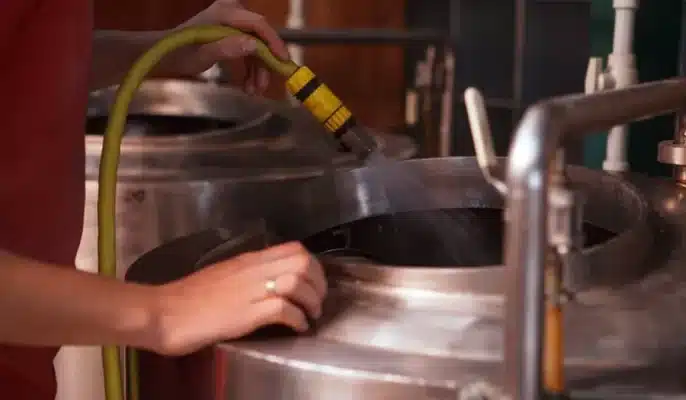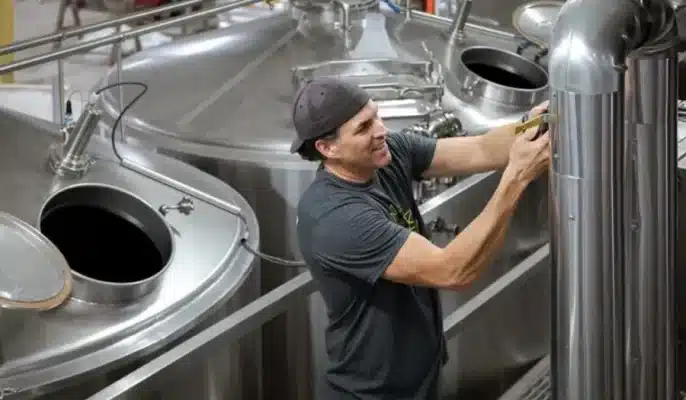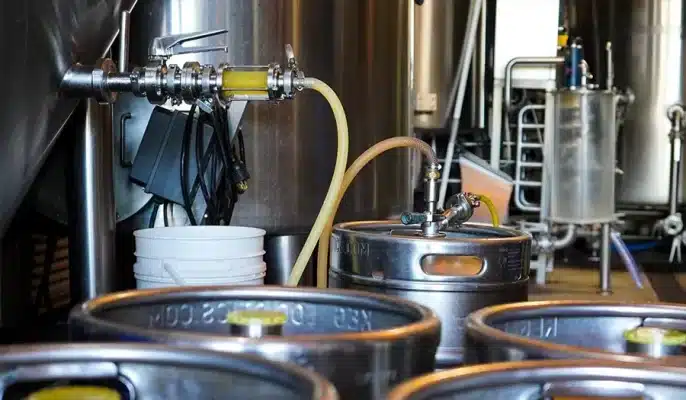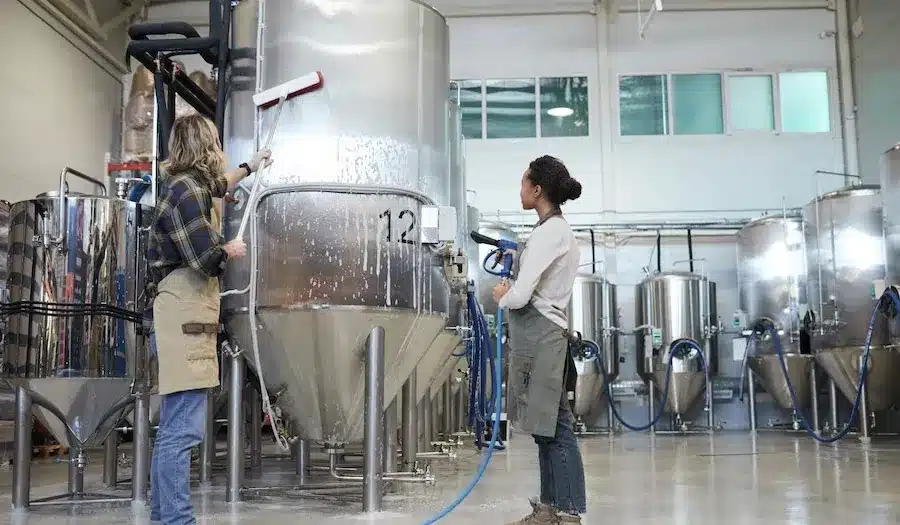Beer brewing is a complex process involving various brewing equipment and materials. During this process, cleaning and disinfection of brewing equipment is essential to ensure the safety and quality of the product. Sanitation is generally considered the most critical step in the beer brewing process. If you are a novice brewer or are about to use a home brewing kit for the first time, you may wonder how to clean the home brewing kit equipment for the best results. This article will detail how to effectively disinfect brewing equipment, including preparation, selection of cleaning steps, precautions, etc., to help brewers better brew delicious beer.
What is dirt?
Dirt is a general term used to describe organic and inorganic deposits. For beer and wine, the most common source of “dirt” is protein and mineral deposits. They come from grains, fruits, hops, and water, and easily adhere to plastics, and when bacteria begin to grow, they form scale, scum, and biofilm.
Dirt is cunning. Your Gärtank may look very clean, but it is full of invisible microorganisms and bacteria. Never “assume” it is clean, this is the root of disaster.

Vorbereitung
Power off and shutdown
Before any cleaning and disinfection work, you must ensure that the equipment has stopped running and the power has been turned off. This not only protects the safety of the operator but also prevents damage to the equipment due to misoperation. Carefully check all brewing equipment, including fermentation tanks, bottles, pipes, filters, etc., to ensure that they are intact and suitable for cleaning and disinfection.
Remove residues
Clean up debris and dirt on the surface of the equipment, including tanks, pipes, valves, pumps, etc. These residues may interfere with the effect of cleaning and disinfection, and even affect the quality of subsequent brewing products.
Prepare tools and disinfectants.
Prepare the required cleaning tools and disinfectants according to the type and scale of the equipment. Common cleaning tools include brushes, sponges, sprayers, high-pressure water guns, etc. The selection of disinfectants should follow the principles of food grade, high efficiency, and safety, such as hydrogen peroxide, bleaching powder, acid disinfectants, or special food grade disinfectants.
Choosing a Disinfectant
- Bleach: Chlorine is the main ingredient and can effectively kill most bacteria and viruses. The recommended concentration is usually between 200-1000 ppm. Be careful when using it because bleach is very irritating.
- Acetic acid: A natural disinfectant suitable for some lighter disinfection needs. Its acidic environment can inhibit bacterial growth, but its killing ability is relatively weak.
- Commercial disinfectant: Many dedicated brewing disinfectant products usually provide strong disinfection effects and are relatively safe for brewing ingredients. When choosing, you should check the product manual to ensure that it meets food safety standards.
- Sodium hydroxide: A strong alkaline disinfectant suitable for removing grease and some stubborn dirt, but it needs to be used with caution to avoid damage to the equipment.
Cleaning steps
- Preliminary cleaning: Disassemble the brewing equipment and clean each part one by one. Use warm water and appropriate detergent to remove surface dirt.
- Use a brush to clean hard-to-reach areas to ensure that there is no residue. Rinse thoroughly with clean water after cleaning.
- Disinfectant preparation: Prepare the disinfectant accurately according to the instructions of the selected disinfectant. Pay attention to the cleanliness of utensils to avoid cross-contamination.
- When preparing the disinfectant, wear gloves and goggles to ensure safety.
- Disinfection treatment: Spray or soak the prepared disinfectant evenly on the equipment. For large surfaces, using a spray bottle can cover more evenly. Make sure that each surface is covered with disinfectant. If necessary, use a brush to gently wipe to ensure that the disinfectant penetrates every corner. The disinfection time depends on the type of disinfectant, generally 10 to 30 minutes.
- Thorough rinsing: After the disinfection is completed, rinse the equipment thoroughly with clean water to ensure that the residue of the disinfectant is removed to avoid affecting the brewed product. Pay special attention to the rinsing of bleach to prevent it from having adverse effects on the brewing substance.
- Drying: Place the cleaned equipment in a well-ventilated environment to dry naturally. A humid environment promotes bacterial growth, so thorough drying is an important step to ensure the disinfection effect.

What happens if you don’t clean your Bierbrauausrüstung?
- Bacterial growth: Residual organic matter and sugars provide a breeding environment for bacteria, resulting in abnormal fermentation and even odors and foreign matter.
- Flavor defects: Contaminants may change the flavor of beer and produce unpleasant odors such as sourness and corruption.
- Fermentation failure: Unclean equipment may cause yeast to lose activity, affect fermentation results, and lead to a decrease in production.
- Product safety risks: Bacterial contamination may cause health risks, produce harmful substances, and affect consumer safety.
- Equipment damage: Long-term accumulation of dirt may corrode equipment and shorten its service life.
How to keep beer equipment clean?
Regelmäßige Reinigung
The first step to keeping beer equipment clean is regular cleaning. After each use, the equipment should be cleaned immediately to avoid residues from drying. This not only helps to remove organic matter and sugar but also prevents bacterial growth. It is recommended to use warm water and a suitable detergent to ensure that each part is thoroughly cleaned.
Use appropriate detergents
Choosing the right detergent is key to ensuring cleaning results. You can use special alkaline or acidic detergents, which can effectively remove dirt and sediment. According to the material of the equipment, choose the right detergent to avoid damaging the equipment.
Thorough rinsing
After cleaning, be sure to rinse the equipment thoroughly with warm water to ensure that all detergents and residues are removed. Residual detergents may affect the flavor and safety of the beer, so the rinsing process should be meticulous and sufficient. You can use a high-pressure water gun to assist in rinsing to ensure that every corner is cleaned.
Regular disinfection
In addition to cleaning, regular disinfection is equally important. Use appropriate disinfectants, such as bleach or special disinfectants, to disinfect the equipment between uses, especially when changing batches or not using the equipment for a long time. Disinfection can effectively kill potential bacteria and microorganisms and ensure the safety of brewing.
Check equipment
Check equipment regularly to ensure that there is no dirt accumulation or damage. This includes checking all related equipment such as fermentation tanks, pipes, filters, etc. Timely detection and resolution of problems can effectively avoid production accidents or quality degradation caused by equipment problems.
Keep the environment clean
It is equally important to keep the brewing environment clean. Clean the work area to prevent dust, debris, and other contaminants from entering the equipment. Use covers to cover unused equipment to reduce the risk of external contamination and ensure the hygiene of the production environment.
Train personnel
Ensure that all operators understand the importance of cleaning and disinfection and master the correct operating methods. Conduct regular training to improve employees’ cleaning awareness and skills so that they can effectively implement cleaning and disinfection procedures in actual operations.

Precautions when cleaning beer brewing equipment
- Follow the instructions: Carefully read and follow the instructions for the use of the cleaning agent, including the recommended concentration and use time, to ensure the best cleaning effect.
- Choose the right disinfectant: When choosing a disinfectant, consider its bactericidal effect, safety, and whether it will corrode the equipment. Food-grade disinfectants are preferred because they will not contaminate brewed products.
- Replace disinfectants regularly: Disinfectants may gradually become ineffective during use, so new disinfectants need to be replaced regularly to ensure the disinfection effect.
- Maintain good hygiene habits: In addition to regular disinfection, you should also maintain good hygiene habits, such as regularly cleaning the surface of the equipment, avoiding bringing debris and contaminants into the brewing area, etc.
- Use protective measures: When performing cleaning and disinfection work, you should wear appropriate protective equipment, such as gloves, masks, and goggles, to protect your safety.
- Avoid cross-contamination: When cleaning different equipment, use different tools and brushes to avoid cross-contamination and ensure that each part can be thoroughly cleaned.
- Thorough rinsing: After cleaning, be sure to rinse the equipment thoroughly with plenty of clean water to ensure that all detergent and dirt residues are removed to avoid affecting the flavor of the beer.
- Regular inspection and maintenance of equipment: Regularly inspect and maintain the equipment, such as replacing seals, lubricating parts, etc., to ensure the normal operation and sanitation of the equipment.
- Training and communication: Ensure that all personnel involved in cleaning have received training, understand the importance of cleaning and the specific operating steps, and maintain good communication and cooperation.




